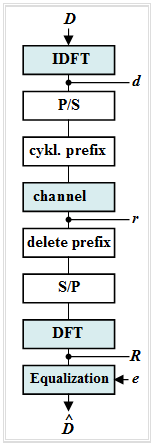Exercise 5.8: Equalization in Matrix Vector Notation
From LNTwww
(Redirected from Aufgabe 5.8: Entzerrung in Matrix–Vektor–Notation)
We consider the blocks of an OFDM system shown in the diagram, assuming a system with $N = 4$ carriers and a channel with $L = 2$ echoes.
- Only a single frame is considered and for the transmission vector (in the time domain), we apply:
- $${\rm\bf{d}} = (d_0, \ d_1,\ d_2,\ d_3 ) = (+1, -1, +1, -1 ).$$
- Let the channel impulse response be described by
- $${\rm\bf{h}} = (h_0, \ h_1,\ h_2 ) = (0, \ 0.6, \ 0.4 ).$$
- To represent the cyclic prefix in this task, instead of the extended transmission vector with the associated transmission matrix ${\rm\bf{H}}_{\rm ext}$, we use the cyclic transmission matrix
- $${\rm\bf{H}}_{\rm{C}} = \left( {\begin{array}{*{20}c} {h_0 } & {h_1 } & {h_2 } & {} \\ {} & {h_0 } & {h_1 } & {h_2 } \\ \hline {h_2 } & {} & {h_0 } & {h_1 } \\ {h_1 } & {h_2 } & {} & {h_0 } \\ \end{array}} \right).$$
- For the spectral coefficients at the receiver, according to the Discrete Fourier Transform $\rm (DFT)$:
- $${\rm\bf{R}} = {\rm\bf{D}} \cdot \left( {\begin{array}{*{20}c} {H_0 } & {} & {} & {} \\ {} & {H_1 } & {} & {} \\ {} & {} & {H_2 } & {} \\ {} & {} & {} & {H_3 } \\ \end{array}} \right) ,$$
- where the diagonal elements are to be calculated as follows:
- $$H_\mu = \sum\limits_{l = 0}^2 {h_l \cdot {\rm{e}}^{ - {\rm{j\hspace{0.04cm}\cdot \hspace{0.04cm}2\pi }} \hspace{0.04cm}\cdot \hspace{0.04cm} l \hspace{0.04cm}\cdot \hspace{0.04cm} {\mu }/{4}} } .$$
- The equalization at the receiver is done by multiplication in the frequency domain by the coefficients $ e_\mu = {1}/{H_\mu }.$
Notes:
- The exercise belongs to the chapter Implementation of OFDM Systems.
- Reference is also made to the chapter Discrete Fourier Transform in the book "Signal Representation".
- For the Discrete Fourier Transform (DFT) in matrix-vector notation holds:
- $${\rm\bf{F}} = \left( {\begin{array}{*{20}c} 1 & 1 & \cdots & 1 \\ 1 & {} & {} & {} \\ \vdots & {} & {{\rm{e}}^{ - {\rm{j2\pi }}{\kern 1pt} \nu {\kern 1pt} \mu /N} } & {} \\ 1 & {} & {} & {} \\ \end{array}} \right), \qquad {\rm{DFT\; with}} \; {1}/{N} \cdot {\rm\bf{F}}; \qquad {\rm{IDFT \; with}} \; {\rm\bf{F}}^*.$$
Questions
Solution
(1) The discrete time domain values at the receiver are calculated using the cyclic transmission matrix ${\rm\bf{H}}_{\rm{C}} $ as follows:
- $${\rm\bf{r}} = {\rm\bf{d}} \cdot {\rm\bf{H}}_{\rm{C}} = \left( {+1 ,-1 ,+1 ,-1 } \right) \cdot \left( {\begin{array}{*{20}c} {0 } & {0.6 } & {0.4 } & {} \\ {} & {0 } & {0.6 } & {0.4 } \\ \hline {0.4 } & {} & {0 } & {0.6 } \\ {0.6 } & {0.4 } & {} & {0 } \\ \end{array}} \right)$$
- $$\Rightarrow \hspace{0.3cm}{\rm\bf{r}} = \left( {r_0 ,r_1 ,r_2 ,r_3 } \right) = \left( {-0.2, +0.2,-0.2, +0.2} \right) \hspace{0.3cm} \Rightarrow \hspace{0.3cm}{\rm Re}[r_0]\hspace{0.15cm} \underline{=-0.2},\hspace{0.2cm} {\rm Im}[r_0]\hspace{0.15cm} \underline{=0}, \hspace{0.2cm}{\rm Re}[r_1]\hspace{0.15cm} \underline{=+0.2},\hspace{0.2cm} {\rm Im}[r_1]\hspace{0.15cm} \underline{=0}. $$
(2) The spectral coefficients ${\rm\bf{D}}$ result directly from the Discrete Fourier Transform $\rm (DFT)$ of the time domain coefficients ${\rm\bf{d}}= (+1, -1, +1, -1)$.
- This time domain sequence corresponds to a discrete cosine function with twice the fundamental frequency $(2 \cdot f_0)$ and amplitude $1$. It follows:
- $${\rm\bf{D}} = \left( {D_0 ,D_1 ,D_2 ,D_3 } \right) =\left( {0, 0,1, 0} \right)\hspace{0.3cm} \Rightarrow \hspace{0.3cm}{\rm Re}[d_2]\hspace{0.15cm} \underline{=1},\hspace{0.2cm} {\rm Im}[d_2]\hspace{0.15cm} \underline{=0}, \hspace{0.2cm}{\rm Re}[d_3]\hspace{0.15cm} \underline{=0},\hspace{0.2cm} {\rm Im}[d_3]\hspace{0.15cm} \underline{=0}.$$
(3) The vector ${\rm\bf{R}}$ of spectral coefficients after the channel could be calculated by DFT of the vector ${\rm\bf{r}}$, analogous to subtask (2).
- An alternative solution path is:
- $${\rm\bf{R}} = {\rm\bf{D}} \cdot \left( {\begin{array}{*{20}c} {H_0 } & {} & {} & {} \\ {} & {H_1 } & {} & {} \\ {} & {} & {H_2 } & {} \\ {} & {} & {} & {H_3 } \\ \end{array}} \right) .$$
- For the diagonal elements one obtains:
- $$H_\mu = \sum\limits_{l = 0}^2 {h_l \cdot {\rm{e}}^{ - {\rm{j\hspace{0.04cm}\cdot \hspace{0.04cm}2\pi }} \hspace{0.04cm}\cdot \hspace{0.04cm} l \hspace{0.04cm}\cdot \hspace{0.04cm}{\mu }/{4}} } \hspace{0.3cm} \Rightarrow \hspace{0.3cm} H_0 = 1,\hspace{0.1cm}H_1 = -0.4 - {\rm{j}} \cdot 0.6,\hspace{0.1cm}H_2 = -0.2,\hspace{0.1cm}H_3 = -0.4 + {\rm{j}} \cdot 0.6 $$
- $$\Rightarrow \hspace{0.3cm}{\rm\bf{R}} = \left( {R_0 ,R_1 ,R_2 ,R_3 } \right)= \left( \hspace{0.15cm}0,\hspace{0.15cm}0,\hspace{0.15cm}-0.2, \hspace{0.15cm}0 \right) \hspace{0.3cm} \Rightarrow \hspace{0.3cm}{\rm Re}[r_2]\hspace{0.15cm} \underline{=-0.2},\hspace{0.2cm} {\rm Im}[r_2]\hspace{0.15cm} \underline{=0}, \hspace{0.2cm}{\rm Re}[r_3]\hspace{0.15cm} \underline{=0},\hspace{0.2cm} {\rm Im}[r_3]\hspace{0.15cm} \underline{=0}.$$
(4) The equalizer coefficients result in $e_\mu = 1/H_\mu$.
- With the result from subtask (3), the coefficients $e_0 = 1$, $e_2 = -5$ are real:
- $${\rm Re}[e_0]\hspace{0.15cm} \underline{=1},\hspace{0.2cm} {\rm Im}[e_0]\hspace{0.15cm} \underline{=0}, \hspace{0.2cm}{\rm Re}[e_2]\hspace{0.15cm} \underline{=-5},\hspace{0.2cm} {\rm Im}[e_2]\hspace{0.15cm} \underline{=0}.$$
- For the other two coefficients:
- $$e_1 = \frac {1}{-0.4 - {\rm{j}} \cdot 0.6} \hspace{0.3cm} \Rightarrow \hspace{0.3cm} {\rm{Re}}[e_1] = \frac {-0.4}{0.4^2 + 0.6^2}\hspace{0.15cm} \underline{ \approx -0.77},\hspace{0.3cm} {\rm{Im}}[e_1] = \frac {0.6}{0.4^2 + 0.6^2} \hspace{0.15cm} \underline{\approx +1.15},$$
- $$e_3 = \frac {1}{-0.4 + {\rm{j}} \cdot 0.6} \hspace{0.3cm}\Rightarrow \hspace{0.3cm} {\rm{Re}}[e_3] = \frac {-0.4}{0.4^2 + 0.6^2}\hspace{0.15cm} \underline{ \approx -0.77},\hspace{0.3cm} {\rm{Im}}[e_3] = \frac {-0.6}{0.4^2 + 0.6^2} \hspace{0.15cm} \underline{\approx -1.15}.$$
(5) The equalization calculated in (4) follows the "zero forcing" approach ⇒ solution 1.
